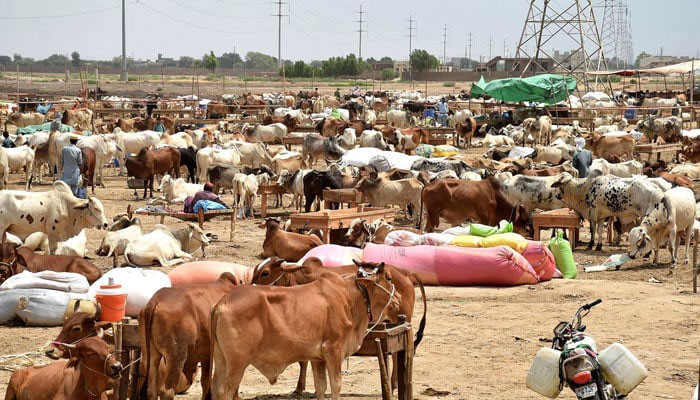Time to remain vigilant for potential threat of Congo fever
Rawalpindi : A huge number of sacrificial animals are being brought to markets in almost all major cities including the twin cities of Islamabad and Rawalpindi from far flung areas of the country ahead of Eidul Azha and according to health experts, it is time for the general public to remain vigilant as incidences of the deadly infection, Crimean-Congo Haemorrhagic Fever cannot be ruled out at the moment.
The mass scale movements of the sacrificial animals may serve as a source of propagation for ticks infested with CCHF thereby increasing the risk of disease transmission. A big chunk of the animals may be taken to the markets without proper handling and surveillance. The sale of animals has already been started in scattered areas of the country and a good number of animals have already been taken to the federal capital and Rawalpindi district.
Experts believe that any of the sacrificial animals being brought to the region for sale may carry ticks and therefore, it is suggested that all the concerned departments including health department, agriculture and livestock departments and tehsil municipal administrations in Rawalpindi division should plan to carry out necessary preventive activities to avoid a possible outbreak of the deadly infection.
The CCHF is endemic in Pakistan and for decades, a significant number of cases of the deadly infection are reported from different parts of the country almost every year. Most of the cases are reported mainly because of improper handling of the animals that have ticks on their skin.
Since the diagnosis of the first human cases of CCHF in 1976, sporadic cases have continued to occur across Pakistan. Although Balochistan remains the most affected province yet cases have been reported from almost all geographical regions of the country. Last year, in October, an outbreak of CCHF with more than 40 cases was reported in Balochistan province.
Crimean-Congo Hemorrhagic Fever that was first described in Crimea in 1944 and identified in 1956 in Congo is zoonotic, a disease that animals cause to humans. The CCHF is caused by Nairovirus of the Bunyaviridae family transmitted to humans by the bite of Hyalomma tick found on the skin of animals including goat and sheep or by direct contact with the blood of an infected animal or human and that is why its incidence is anticipated every year before Eidul Azha. Exposure to the blood or tissue of the infected animal during or post slaughtering and direct contact with blood or secretions of an infected person may also cause transmission. The case fatality rate of the deadly infection ranges from 2% to 50%. Medically, a confirmed patient of CCHF is an important source of exposure for other people, particularly family members and healthcare workers.
Experts say that individuals must take necessary preventive measures while taking sacrificial animals home. The animals having any type of ticks on their skin, should be given a thorough bath with water carrying DEET or Potassium Permanganate.
People should reduce tick infestation on cows, sheep and goats with the help of insecticides. Acaricides, the pesticides that kill ticks and mites may be useful on domestic animals if used 10-14 days prior to slaughter or to the export of animals and insecticidal sprays must be ensured in the cattle markets, slaughter houses, dairy, Gawala colonies, sacrificial animals’ sale yards and other animal gathering places. Also insect repellents containing DEET are effective in protecting against ticks.
People should wear protective clothing when working with livestock and to take measures for early and correct removal of ticks. People should ensure examination of diseased animals from veterinary doctors so that transmission of CCHF to human beings could be avoided.
-
 Queen Camilla Supports Charity's Work On Cancer With Latest Visit
Queen Camilla Supports Charity's Work On Cancer With Latest Visit -
 Dove Cameron Opens Up About Her Latest Gig Alongside Avan Jogia
Dove Cameron Opens Up About Her Latest Gig Alongside Avan Jogia -
 Petition Against Blake Lively PGA Letter Gains Traction After Texts With Taylor Swift Revealed
Petition Against Blake Lively PGA Letter Gains Traction After Texts With Taylor Swift Revealed -
 Netflix Revises Warner Bros. Deal To $83 Billion: All-cash Offer
Netflix Revises Warner Bros. Deal To $83 Billion: All-cash Offer -
 Prince Harry Mentions Ex-girlfriend Chelsy Davy In UK Court
Prince Harry Mentions Ex-girlfriend Chelsy Davy In UK Court -
 David, Victoria Beckham 'quietly' Consulting Advisers After Brooklyn Remarks: 'Weighing Every Move'
David, Victoria Beckham 'quietly' Consulting Advisers After Brooklyn Remarks: 'Weighing Every Move' -
 Meta's New AI Team Delivered First Key Models
Meta's New AI Team Delivered First Key Models -
 Prince Harry Defends Friends In London Court
Prince Harry Defends Friends In London Court -
 AI May Replace Researchers Before Engineers Or Sales
AI May Replace Researchers Before Engineers Or Sales -
 Christina Haack Goes On Romantic Getaway: See With Whom
Christina Haack Goes On Romantic Getaway: See With Whom -
 Consumers Spend More On AI And Utility Apps Than Mobile Games: Report
Consumers Spend More On AI And Utility Apps Than Mobile Games: Report -
 Aircraft Tragedy: Missing Tourist Helicopter Found Near Japan Volcano Crater
Aircraft Tragedy: Missing Tourist Helicopter Found Near Japan Volcano Crater -
 Taylor Swift Lands In Trouble After Blake Lively Texts Unsealed
Taylor Swift Lands In Trouble After Blake Lively Texts Unsealed -
 'Prince Harry Sees A Lot Of Himself In Brooklyn Beckham'
'Prince Harry Sees A Lot Of Himself In Brooklyn Beckham' -
 Kate Middleton’s Cancer Journey Strengthens Her Commitment To Helping Children
Kate Middleton’s Cancer Journey Strengthens Her Commitment To Helping Children -
 Gaten Matarazzo Compares 'Stranger Things' Ending To 'Lord Of The Rings'
Gaten Matarazzo Compares 'Stranger Things' Ending To 'Lord Of The Rings'




